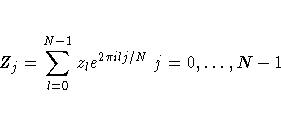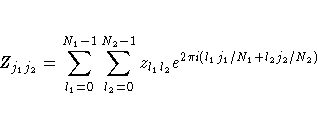Chapter Contents
Previous
Next
|
Chapter Contents |
Previous |
Next |
| The KDE Procedure |
The discrete Fourier transform of a complex vector z = (z0, ... ,zN-1) is the vector Z = (Z0, ... ,ZN-1) where


Discrete Fourier transforms and their inverses can be computed quickly using the FFT algorithm, especially when N is highly composite; that is, it can be decomposed into many factors, such as a power of 2. By the Discrete Convolution Theorem, the convolution of two vectors is the inverse Fourier transform of the element-by-element product of their Fourier transforms. This, however, requires certain periodicity assumptions, which explains why the vectors K and C require zero-padding. This is to avoid "wrap-around" effects (refer to Press et al. 1988, pp. 410 - 411). The vector K is actually mirror-imaged so that the convolution of C and K will be the vector of binned estimates. Thus, if S denotes the inverse Fourier transform of the element-by-element product of the Fourier transforms of K and C, then the first g elements of S are the estimates.
The bivariate Fourier transform of an
N1×N2 complex matrix
having (l1+1,l2+1) entry equal to
![]() is the
N1×N2 matrix with (j1+1 ,j2+1) entry given by
is the
N1×N2 matrix with (j1+1 ,j2+1) entry given by


|
Chapter Contents |
Previous |
Next |
Top |
Copyright © 1999 by SAS Institute Inc., Cary, NC, USA. All rights reserved.